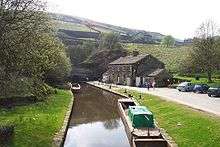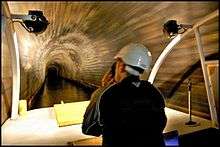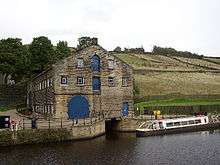Standedge Tunnels
 Tunnel End Cottages and the entrance portal at Marsden | |
| Overview | |
|---|---|
| Location | Standedge |
| Coordinates | 53°35′28″N 1°57′44″W / 53.59107°N 1.96219°WCoordinates: 53°35′28″N 1°57′44″W / 53.59107°N 1.96219°W |
| OS grid reference | SE026105 |
| Status | Open |
| Waterway | Huddersfield Narrow Canal |
| Start | 53°34′05″N 1°59′34″W / 53.568042°N 1.992684°W |
| End | 53°36′13″N 1°56′33″W / 53.603622°N 1.942506°W |
| Operation | |
| Constructed | 1794–1811 |
| Opened | 1811 |
| Closed | 1944 |
| Rebuilt | 2001 |
| Owner | Canal & River Trust |
| Technical | |
| Design engineer |
Nicholas Brown Thomas Telford |
| Length | 5,500 yards (5,029 m) |
| Towpath | No |
| Boat-passable | Yes (with permission) |
The Standedge Tunnels are four parallel tunnels beneath the Pennines in northern England. Three are railway tunnels and the other is a canal tunnel. They are located at the Standedge (pronounced Stannige) crossing point between Marsden and Diggle, across the boundary between the West Yorkshire and Greater Manchester conurbations. Before boundary changes in 1974, both ends of the tunnel were in the West Riding of Yorkshire.
The canal tunnel is on the Huddersfield Narrow Canal. It opened in 1811 and is the longest and oldest of the four and is the longest and highest canal tunnel in the United Kingdom.[1] The first single-track railway tunnel was completed by the London and North Western Railway (LNWR) in 1848 on the line between Huddersfield and Manchester and a second parallel tunnel opened in 1871. The LNWR opened a third tunnel with double tracks in 1894. All four tunnels are linked by cross-tunnels or adits at strategic intervals, which allowed the railway tunnels to be built quickly, reducing the need for construction shafts, as waste could be removed by boat.
Of the railway tunnels, only the one built in 1894 is currently used for rail traffic. Closed in 1943, the canal tunnel was re-opened in May 2001. The Standedge Tunnel Visitor Centre, at the Marsden end, is a base for boat trips into the tunnel and hosts an exhibition depicting the different crossings.
Canal tunnel
| Standedge Tunnel | |||||||||||||||||||||||||||||||||||||||||||||||||||||||||||||||||||||||||||||||||||||||||||||||||||||||||||||||||||||||||||||||||||||||||||||||||||||||||||||||||||||||||||||||||||||||||||||||||||||||||||||||||||||||||||||||||||||||||||||||||||||||||||||||||||||||||||||||||||||||
|---|---|---|---|---|---|---|---|---|---|---|---|---|---|---|---|---|---|---|---|---|---|---|---|---|---|---|---|---|---|---|---|---|---|---|---|---|---|---|---|---|---|---|---|---|---|---|---|---|---|---|---|---|---|---|---|---|---|---|---|---|---|---|---|---|---|---|---|---|---|---|---|---|---|---|---|---|---|---|---|---|---|---|---|---|---|---|---|---|---|---|---|---|---|---|---|---|---|---|---|---|---|---|---|---|---|---|---|---|---|---|---|---|---|---|---|---|---|---|---|---|---|---|---|---|---|---|---|---|---|---|---|---|---|---|---|---|---|---|---|---|---|---|---|---|---|---|---|---|---|---|---|---|---|---|---|---|---|---|---|---|---|---|---|---|---|---|---|---|---|---|---|---|---|---|---|---|---|---|---|---|---|---|---|---|---|---|---|---|---|---|---|---|---|---|---|---|---|---|---|---|---|---|---|---|---|---|---|---|---|---|---|---|---|---|---|---|---|---|---|---|---|---|---|---|---|---|---|---|---|---|---|---|---|---|---|---|---|---|---|---|---|---|---|---|---|---|---|---|---|---|---|---|---|---|---|---|---|---|---|---|---|---|---|---|---|---|---|---|---|---|---|---|---|---|---|---|---|---|---|
Legend | |||||||||||||||||||||||||||||||||||||||||||||||||||||||||||||||||||||||||||||||||||||||||||||||||||||||||||||||||||||||||||||||||||||||||||||||||||||||||||||||||||||||||||||||||||||||||||||||||||||||||||||||||||||||||||||||||||||||||||||||||||||||||||||||||||||||||||||||||||||||
| |||||||||||||||||||||||||||||||||||||||||||||||||||||||||||||||||||||||||||||||||||||||||||||||||||||||||||||||||||||||||||||||||||||||||||||||||||||||||||||||||||||||||||||||||||||||||||||||||||||||||||||||||||||||||||||||||||||||||||||||||||||||||||||||||||||||||||||||||||||||


The Standedge Tunnel is the longest, deepest and highest canal tunnel in Britain. It is 5,500 yards (5,000 m) long, 636 feet (194 m) underground at its deepest point, and 643 feet (196 m) above sea level.[2]
Construction
Benjamin Outram was the consulting engineer for the construction of the Huddersfield Narrow Canal (then known as the Huddersfield Canal) which was authorised by an act of Parliament on 4 April 1794 to link Ashton-under-Lyne and Huddersfield via a tunnel. His report in October 1793 estimated the cost of the canal and tunnel at £178,478. Nicholas Brown surveyed the route. Outram thought that the hill through which the tunnel was to be cut was composed of gritstone and strong shale and should not present any difficulties. He expected to start work on the 5,456-yard (4,989 m) tunnel at a dip in the hill at Red Brook and from both ends and use steam engines to keep the works drained.[3]
Work began with Outram acting as engineer and Brown acting as superintendent and surveyor. In July 1795, John Evans was appointed to manage the boring of the tunnel. By mid-1796, 795 yards (727 m) of tunnel had been cut, some of which had been lined, but much effort had been spent on constructing small tunnels to supply waterwheels which would raise spoil and water from the intermediate adits. By the autumn, there was concern that such work was expensive but had not contributed anything to the task in hand and soon afterwards, Outram abandoned the attempt to build extra workfaces in order to concentrate on working from both ends. Although cheaper, this choice extended the completion date. Tunnelling was hampered by much larger quantities of water entering the workings than had been expected. In September 1797, Outram advised the management committee that Thomas Lee, the first contractor to be employed on the tunnel works, had made large losses as a result of the difficulties and could not complete his contract. He was awarded more money for timber, an increased rate per yard for completion and an extra year in which to finish.[4]
By the middle of 1799, 1,000 yards (910 m) of the tunnel had been finished and a further 1,000 yards (910 m) had been excavated but not completed. In October 1800, the Peak Forest Canal Company, who were keen to trade through the tunnel, suggested that a tram road should be built to bypass the tunnel until it was completed but although Outram looked at this option, no action was taken. The next tunnel contract failed to attract any takers so John Varley, who had been working on repairs to parts of the canal which had been damaged by floods, was asked to do some tunnelling. Next, Matthew Fletcher, who had experience of mining, was asked for an opinion. He suggested that time could be saved by tunnelling in both directions from Redbrook pit which was being kept dry by a large steam engine. He estimated that this would cost an additional £8,000 but although the committee tried to find a contractor to carry out the work, none could be found and tunnelling continued from both ends.[5]
Outram left the project in 1801 after work had stopped for a lengthy period.[6] In late 1804, the committee began to address the issue of how the tunnel would be worked and a sub-committee visited the Harecastle Tunnel on the Trent and Mersey Canal, the Butterley Tunnel on the Cromford Canal and the Norwood Tunnel on the Chesterfield Canal. After seeing them, they recommended that a towing path should be built through the tunnel but the extra cost and delays could not be afforded. Desperately short of money, the canal company obtained a new act of Parliament in 1806 to raise additional finance and to allow an extra toll for using the tunnel to be charged.[7] In 1807, Thomas Telford was asked for advice on construction and planning and produced a detailed plan which was carefully followed until the work was completed.[6] On 9 June 1809, the two ends of the tunnel finally met. Nearly two years after that, on 26 March 1811, the tunnel was declared to be complete and a grand opening ceremony was held on 4 April. A party of invited guests, followed by several working boats, entered the tunnel at Diggle and completed the journey to Marsden in one hour and forty minutes. The tunnel had cost some £160,000 and was the most expensive canal tunnel built in Britain.[7]
Completion
When the tunnel eventually opened, the canal became a through route, 13 years after the rest of it had been completed and 17 years after work first began, at a cost of £123,803. Despite multiple problems, the building of the Huddersfield Narrow canal showed that the technique of quantity surveying had advanced greatly. Telford's report covered every expenditure to the last bucket - it was followed to the letter until the canal finally opened. Between 1811 and 1840, the tunnel was used on average by 40 boats daily.[8] The canal tunnel was brick-lined in places though bare rock was left exposed in others.[9]
Operation
The canal tunnel is only wide enough for one narrowboat for much of its length and to save on cost, as in some other canal tunnels in England, a tow-path was not provided in the tunnel. As canal boats were horse-drawn, the boats had to be legged through the tunnel – a process where one or more boatmen lay on the cargo and pushed against the roof or walls of the tunnel with their legs. Professional leggers were paid one Shilling and six Pence for working a boat through the tunnel which took one hour and twenty minutes for an empty boat and three hours with a full load.[10]
There are several widened points in the tunnel which were originally designed to be passing places. However, due to intense competition between boat crews, two-way operation in the tunnel was found to be impractical. The canal company introduced a new method of working where one end of the tunnel was closed off by a locked chain preventing access to the tunnel unless authorised. A similar system is used today.[9]
The Huddersfield Narrow Canal was purchased by the 'Huddersfield and Manchester Railway' in 1846. The canal tunnel proved most beneficial in assisting with the construction of the first railway tunnel at this location as no vertical shafts were needed in the construction and the canal was an easy way to help remove the large amount of spoil excavated. Several cross-passages were retained.[9]
The last commercial boat to use the tunnel passed through in 1921 and the canal was officially closed in 1944 after which it soon fell into disrepair.
Most quotes on the internet state the last boat through the tunnel was the Rolt/Aickman expedition in the leaky Ailsa Craig in 1948 when the tunnel was in unknown condition.[11] Tom Rolt, writing in 1948, stated that he had recently traversed the tunnel. The journey took two hours, speed was kept very low intentionally so as to avoid damage to the boat.[12] The canal was blocked at several locations on both sides of the Pennines. The tunnel became unsafe and was closed by large iron gates at each end.
A local newspaper described a trip organised by the Railway and Canal Historical Society in 1961 to commemorate 150 years since building work on the canal was complete. A narrowboat left Marsden around 11 a.m. and emerged from the Diggle portal around 1 p.m.[13]
Restoration
The canal tunnel was the beneficiary of a £5 million restoration project as part of an effort to re-open the entire canal. Several rock-lined parts of the tunnel were found to be unstable. Where possible, these were stabilised by rock bolts, or where impractical, concrete was used to stabilise the rock face. The tunnel re-opened in May 2001.
Most modern canal boats are diesel-powered. When the canal was reopened, it was felt that it would not be safe for boaters to navigate the tunnel under their own diesel power due to the extreme length of the tunnel and the lack of ventilation. Instead, electric tug boats hauled narrowboats through the tunnel.[14] Typical operation was to tightly bind three or four boats together in a long row with the electric tug at the head. The cavalcade would then proceed slowly through the tunnel with the boat crews travelling in the tug and a British Waterways operative steering the last boat in the chain. Nobody was allowed to travel on the intermediate boats. Despite rudimentary protection measures such as strips of thick rubber conveyor belting being put in place on the boat gunwales and roofs, extensive impact damage to the intermediate unsteered boats was quite common with this method of working.
In September 2007, it was identified that significant repairs were required to one of the electric tug modules and British Waterways carried out a trial run for self-steer operation. The trip boat Pennine Moonraker was taken through the tunnel under her own power by owner John Lund, shadowed by a BW electric tug.
Since the 2009 season, boats have been allowed to travel through the tunnel under their own power, with a chaperone on the boat, followed by a service vehicle through a parallel disused railway tunnel.[15][16]

Railway tunnels
There are three railway tunnels running parallel to each other and the canal tunnel. The railway tunnels are level for their whole length providing the only section of level track on the line where water troughs could be installed to provide steam locomotives with fresh water supplies without the requirement for the train to stop.
The central tunnel was completed in 1848 by the London and North Western Railway having acquired the former Huddersfield and Manchester Railway in 1847. This was a single line tunnel with a length of 3 miles, 57 yards (4,803 m). The tunnel is located immediately to the south of, but at a slightly higher level than, the canal tunnel.[17][18]
The 1848 tunnel soon proved to be a bottleneck for rail traffic between Huddersfield and Manchester, and in 1871 a second parallel tunnel was opened. This tunnel was also a single line tunnel with a length of 3 miles, 57 yards (4,803 m) and was situated to the south of the first rail tunnel.

The 1894 double-bore tunnel was opened by the London and North Western Railway with double track and a length of 3 miles, 60 yards (4,806 m). For most of its length, it is situated to the north of the canal tunnel but passes over the canal tunnel just inside each tunnel entrance. The canal tunnel was extended at the Diggle end as part of the construction works of the 1894 tunnel.[19] It is the fifth-longest rail tunnel in Britain after the new High Speed 1 tunnels, Severn Tunnel and the Sheffield to Manchester route's Totley Tunnel.[17] Only the 1894 rail tunnel is still operational although all three rail tunnels are still maintained. The 1848 tunnel provides an emergency escape route for the other tunnels and has been made accessible to road vehicles such as fire engines and ambulances.
Network Rail proposed the reinstatement of rail traffic through the 1871 and 1848 tunnels to increase capacity on the trans-Pennine route[20] but following a re-appraisal in the light of the decision to electrify the Leeds-Manchester trans-Pennine line, it was reported in 2012 that reinstatement was unnecessary.
Standedge Tunnel Visitor Centre

The Standedge Tunnel Visitor Centre at the Marsden end of the tunnel is located in the former warehouse used for transshipment of goods from canal barge to packhorse between 1798 when the canal reached Marsden and 1811 when the tunnel opened. The centre contains exhibitions on the history of the tunnels, the canal tunnel's recent restoration and the Huddersfield Narrow Canal.
Tunnel End Cottages which formerly housed canal maintenance workers, houses a cafe and the booking office for 30-minute boat trips into the tunnel. The trips use electric tugs that push a passenger-carrying barge.
The visitor centre is about half a mile (0.8 km) west of Marsden railway station which can be reached via the towpath of the Huddersfield Narrow Canal which runs adjacent to the station. Adjacent to the railway station is the headquarters of the National Trust's Marsden Moor Estate which includes a public exhibition, Welcome to Marsden, that gives an overview of the area and its transport history.[21]
See also
Bibliography
- Gagg, John (1976). Canal Tunnels. Bucks UK John Gagg. ISBN 9780950422626.
- Hadfield, Charles; Biddle, Gordon (1970). The Canals of North West England, Vol 2 (pp.241–496). David and Charles. ISBN 0-7153-4992-9.
- Rolt, L. T. C. (1950). The Inland Waterways of England. London: George Allen and Unwin Ltd. ISBN 0-04-386003-6.
- Skempton, Sir Alec; et al. (2002). A Biographical Dictionary of Civil Engineers in Great Britain and Ireland: Vol 1: 1500 to 1830. Thomas Telford. ISBN 0-7277-2939-X.
References
- ↑ "Transportation Uses - Standedge Tunnels". standedge.co.uk. Retrieved 4 September 2010.
- ↑ "Standedge Tunnel – A true wonder of the waterways". British Waterways. Retrieved 23 January 2009.
- ↑ Hadfield & Biddle 1970, pp. 322–323
- ↑ Hadfield & Biddle 1970, pp. 324–325
- ↑ Hadfield & Biddle 1970, pp. 325–328
- 1 2 Skempton 2002, p. 495
- 1 2 Hadfield & Biddle 1970, pp. 328–329
- ↑ Mary Hodge (1994). "The Saddleworth Story" (5th reprint ed.). p. 19.
- 1 2 3 "History". Pennine Waterways. Retrieved 16 October 2006.
- ↑ "Marsden History Group website". Retrieved 4 September 2010.
- ↑ "Pennine Waterways website". Retrieved 4 September 2010.
- ↑ Rolt 1950, pp. 88–89
- ↑ "Media story & image of Historical Society boat trip from 1961". Retrieved 25 July 2009.
- ↑ "Modern Operation". Huddersfield Canal Society. Retrieved 23 January 2009.
- ↑ "Standedge Tunnel". British Waterways. Retrieved 6 February 2011.
- ↑ "Standedge Tunnel Customer Guidelines" (PDF). British Waterways. Retrieved 6 February 2011.
- 1 2 "Communications and Transport in the Marsden area". Marsden Local History Group. Archived from the original on 31 December 2006. Retrieved 7 January 2007.
- ↑ "Huddersfield Narrow Canal Facts". Huddersfield One. Retrieved 7 January 2007.
- ↑ Gagg 1976
- ↑ "Manchester Hub Rail Study" (PDF). Network Rail. p. 51. Retrieved 17 February 2010.
- ↑ "Marsden Moor – What to see and do". National Trust. Archived from the original on 22 July 2006. Retrieved 24 December 2006.
External links
| Wikimedia Commons has media related to Standedge Tunnels. |
- Internal Standedge tunnel pictures can be seen here
- Aerial photos of the Diggle portal and the Marsden portal
- Standedge Tunnel Visitor Centre
- Waterscape services directory
- Standedge Tunnel
- A walk between Marsden Station and Standedge Tunnel from TripsByTrain.com
| Records | ||
|---|---|---|
| Preceded by Sapperton Canal Tunnel |
Longest tunnel 1811–1871 |
Succeeded by Fréjus Rail Tunnel |